The infernos of January 2020 will be remembered for destroying so much of southeastern Australia. I weep for the burns’ victims. So many people and so much wildlife in so much pain.
In terms of area of land burnt, these last few weeks may be recorded as unprecedented. This has everything to do with our mismanagement of the landscape, including the lack of hazard reduction burning especially in eucalyptus forests.
We were warned in the report from the 1939 Royal Commission by Judge Leonard Stretton, and in the more than 18 major inquiries since, forests are potentially dangerous and explosive places. Fuel loads must be kept within acceptable limits.
Blaming the recent fires on climate change is to rewrite our temperature history, something the Australian Bureau of Meteorology has been doing for some time. This has involved the:
- remodelling of measured values
- addition of hotter locations to only the most recent years in the compilation of a national average trend
- transition to electronic probes that are designed to record hotter for the same weather, and
- deleting of the hottest day in the official record, which was January 3, 1909.
These misdeeds have all been comprehensively documented, yet the current government turns a blind eye, while referring the matter of a firefighter who claims an Indigenous heritage to the Australian federal police. It is as though we are ruled over by a political elite more interested in continuing subsidies to electricity companies, and continuing funding to corrupt coral reef researchers – both of which have a vested interest in catastrophe – rather than listening to practical solutions to these and other major environment issues currently confronting Australia.
BUSHFIRE HISTORY, REMEMBERING JANUARY 1939
The “Report of the Royal Commission to inquire into the causes of and measures taken to prevent the bush fires of January 1939 and to protect life and property and the measures to be taken to prevent bush fires in Victoria and to protect life and property in the event of future bush fires” begins:
In the State of Victoria, the month of January of the year 1939 came towards the end of a long drought which had been aggravated by a severe hot, dry summer season. For more than twenty years the State of Victoria had not seen its countryside and forests in such travail. Creeks and springs ceased to run. Water storages were depleted. Provincial towns were facing the probability of cessation of water supply. In Melbourne, more than a million inhabitants were subjected to restrictions upon the use of water.
“Throughout the countryside, the farmers were carting water, if such was available, for their stock and themselves. The rich plains, denied their beneficent rains, lay bare and baking; and the forests, from the foothills to the alpine heights, were tinder. The soft carpet of the forest floor was gone; the bone-dry litter crackled underfoot; dry heat and hot dry winds worked upon a land already dry, to suck from it the last, least drop of moisture. Men who had lived their lives in the bush went their ways in the shadow of dread expectancy. But though they felt the imminence of danger they could not tell that it was to be far greater than they could imagine. They had not lived long enough. The experience of the past could not guide them to an understanding of what might, and did, happen. And so it was that, when millions of acres of the forest were invaded by bushfires which were almost State-wide, there happened, because of great loss of life and property, the most disastrous forest calamity the State of Victoria has known.
“These fires were lit by the hand of man
“Seventy-one lives were lost. Sixty-nine mills were burned. Millions of acres of fine forest, of almost incalculable value, were destroyed or badly damaged. Townships were obliterated in a few minutes Mills, houses, bridges, tramways, machinery, were burned to the ground; men, cattle, horses, sheep, were devoured by the fires or asphyxiated by the scorching debilitated air. Generally, the numerous fires which during December, in many parts of Victoria, had been burning separately, as they do in any summer, either ‘under control’ as it is falsely and dangerously called, or entirely untended, reached the climax of their intensity and joined forces in a devastating confluence of flame on Friday, the 13th of January.
“On that day it appeared that the whole State was alight. At midday, in many places, it was dark as night. Men carrying hurricane lamps, worked to make safe their families and belongings. Travellers on the highways were trapped by fires or blazing fallen trees, and perished. Throughout the land there was daytime darkness.”
THE IMPORTANCE OF HAZARD REDUCTION BURNING
Just last week, at the height of the January 2020 bushfire emergency, Minister for Home Affairs Peter Dutton referred a complaint against a firefighter, who allegedly falsely claims Aboriginal heritage, to the Australian federal police. I have no opinion on Bruce Pascoe’s lineage, but I do know that the Mob he identifies with have real solutions to our recurrent bushfire tragedies. Their culture has a long history of land management through the expert use of fire as a tool to create visually pleasing and practical mosaics resistant to the spread of wildfires.
Bruce Pascoe’s book Dark Emu draws from the more technical work by Bill Gammage entitled “The Biggest Estate on Earth”. This tome explains how Aborigines actively and skilfully managed the land in a far more systematic way than has ever been acknowledged. And I know, from my time spent reading original sources at the South Australian Museum about the Yaraldi of the Lower Murray River, that there were also complicated systems of governance, with a focus on a sustainable harvest and the storage of food.
Judge Stretton’s 1939 report also noted:
When the early settlers came to what is now this state [of Victoria], they found for the greater part a clean forest.Apparently, for many years before their arrival, the forest had not been scourged by fire … Their canopies had prevented the growth of scrub and bracken to any wide extent. They were open and traversable by men, beasts and wagons. Compared to their present condition, they were safe” (p. 11).
While quick to refer Bruce Pascoe, who is best known for his unorthodox perspective on Aboriginal history, to the federal police, Minister Dutton and his government have over a very long period of time turned a blind eye to the rewriting of Australia’s historical temperature record by Blair Trewin and David Jones of the Australian Bureau of Meteorology. The work of Trewin and Jones underpins the notion of an unprecedented climate emergency, when the real issues are perhaps management of fuel loads in forests and current resourcing.
Indeed, now absurdly corralled by the climate change meme, Prime Minister Scott Morrison is actively promoting the need for yet another Royal Commission as though this will prevent future bush fire tragedies. Yet recommendations of previous Royal Commissions have never been implemented. For example, a hazard reduction burn across at least 390,000 hectares each year was recommended for the state of Victoria.
It is because “The Elites” don’t trust the work of practical land managers, whether that be thinning young forests to ensure that a proper over-storey canopy develops, or adopting straight-forward hazard reduction burningprogrammes. Climate change may be a convenient scapegoat, but it will not protect our land into the future.
HOTTER AND DRIER SUMMERS
Sunday morning on national television the Prime Minister said a Royal Commission into “the killer bushfire season” is necessary and reiterated claims that the nation is facing a “new normal”, with more severe natural disasters on the way; he said he would be seeking more powers to allow the Australian Defence Force to respond more quickly.
Bill Gates has famously said that if you can’t measure it you can’t manage it, and that fundamental to improvement is the capacity to accurately measure.
Yet we have a situation where key statistics are either remodelled or ignored.
Mr Morrison mentioned hotter and drier summers in his television address. The historical record shows that the land mass of Australia is not drying out. Last year, 2019, was exceptionally dry. But the long-term trend is not towards a drier continent but rather we have on average had consistently wetter years since the 1970, as shown in Figure 1.
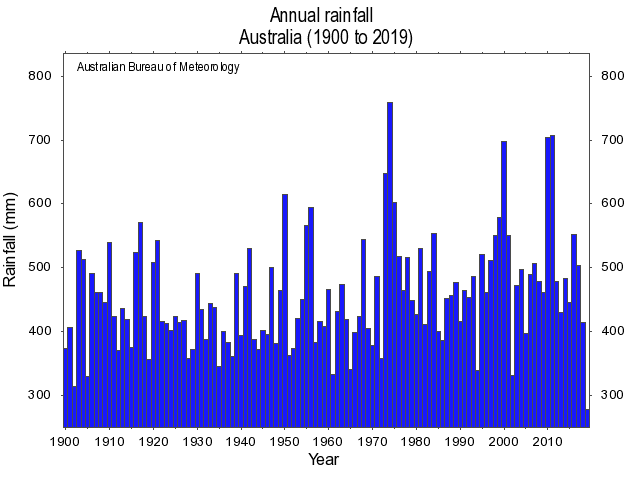
It is also the case that summers are not getting drier, as shown in Figure 2.
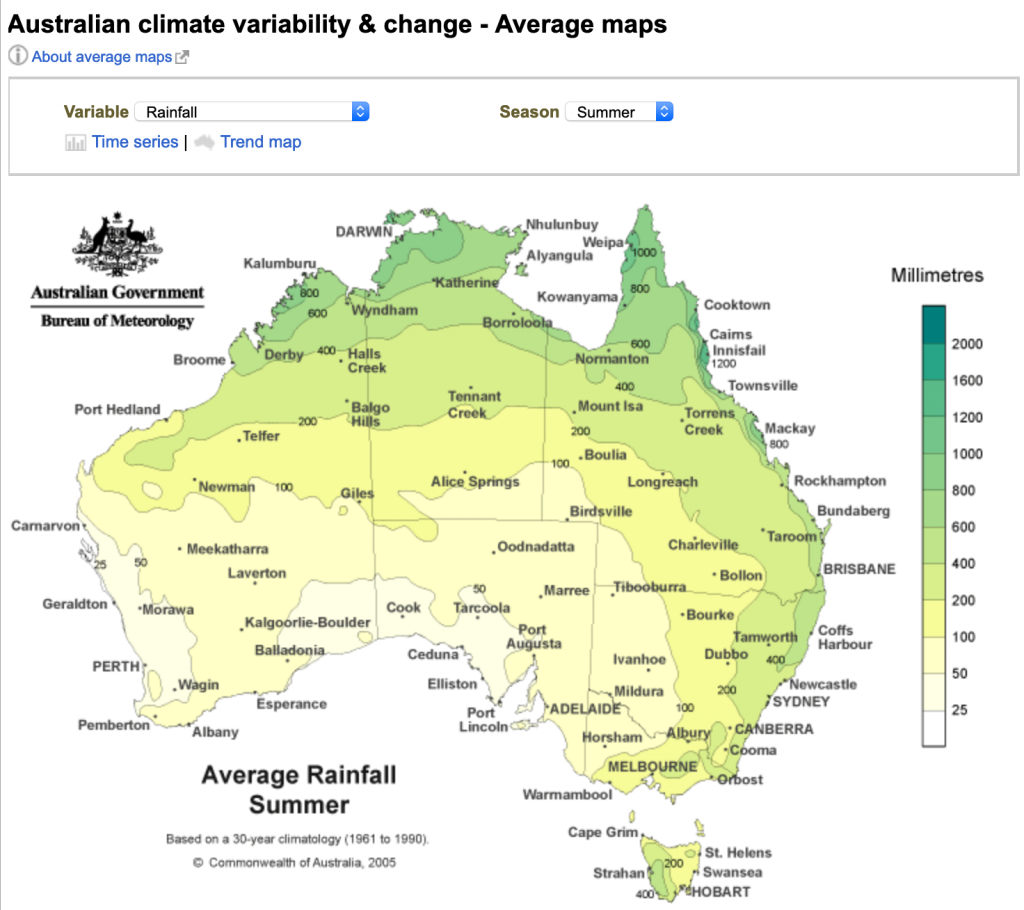
According to the Bureau, recent summers have been hotter, but such claims would not pass scrutiny if assessed, for example, for inclusion in the Guinness Book of records. This is because of all the changes to the way temperatures are now measured.
The Rutherglen agricultural research station has one of the longest, continuous, temperature records for anywhere in rural Victoria. Minimum and maximum temperatures were first recorded at Rutherglen using standard and calibrated equipment back in November 1912. Considering the first 85 years of summer temperatures – unadjusted, as in not homogenised – the hottest summer on record at Rutherglen is the summer of 1938–1939.

At Rutherglen, the first big equipment change happened on 29 January 1998. That is when the mercury and alcohol thermometers were replaced with an electronic probe – custom built to the Australian Bureau of Meteorology’s own standard, with the specifications still yet to be made public.
According to Bureau policy, when such a major equipment change occurs there should be at least three years (preferably five) of overlapping/parallel temperature recordings. Except the mercury and alcohol thermometers (used to measure maximum and minimum temperatures, respectively) were removed on exactly the same day the custom-built probe was placed into the Stevenson screen at Rutherglen, in direct contravention of this policy.
The policy implications are significant, far more significant than Bruce Pascoe paraphrasing some text from the early explorers to make a point, while claiming an Aboriginal heritage.
In 2011, the Bureau made further changes to how it measures temperatures in that it stopped averaging one-second readings from the probe at Rutherglen over one minute. The maximum temperature as recorded each day at Rutherglen is now the highest one-second spot reading from the custom-built probe. That is correct – spot reading.
Across Australia non-standard methods of measuring (spot readings) from non-standard equipment (custom-built probes) make it impossible to establish the equivalence of recent temperatures from Rutherglen – or any of the Bureau’s other 695 probes in automatic weather stations – with historical data.
REWRITING OUR TEMPERATURE HISTORY
It was at the Sydney Institute in 2014 that I first began to detail the extent to which the Australian Bureau of Meteorology has rewritten our temperature history to create the impression of catastrophic global warming using the technique of homogenisation. This is in addition to the issues with calibration.
Back in 2014, I showed how temperatures are changed in the ACORN database, and not by a small amount. I showed that the recorded values — the actual measurements — are often changed by more than a degree from the original measurements to remove the cooling trend from at least 1940 to 1960. Cooling the past, makes the present appear hotter.
If we consider, as an example, Bourke in western New South Wales, the temperature as measured using a mercury thermometer in a Stevenson Screen at the official recording station was 38.9 degrees Celsius. This value was changed to 38.4 in the first official ACORN database, and then dropped-down by a further 0.3 degrees when the Bureau published version 2 of ACORN.
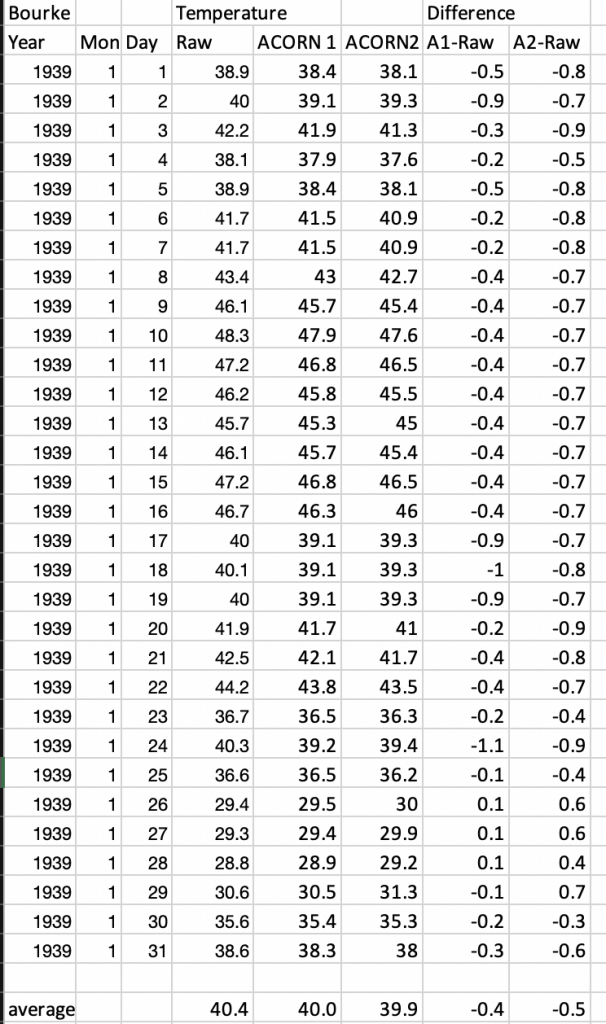
This is in addition to the more recent issues that I have uncovered, issues caused by the transition to electronic probes without due regard to calibration. In the case of Mildura, I have shown that the official electronic probe is regularly recording 0.4 °C hotter than the mercury thermometer in the same shelter.
Then there is the issue of how all the temperature series are added together.
Concerned that the Bureau made many errors in its calculation of the mean Australian temperature, Merrick Thomson, a retired accountant, asked questions in a submission to a government inquiry some years ago, specifically:
- Why was the mix of stations changed with the transition to ACORN, and why was this not explained and declared, particularly given that it has resulted in a large increase in theannualtemperature for Australia.Hecalculates this was 56 °C.
- What criteria is used to determine whether or not a station becomes part of the national network, and specifically, why was the very hot location of Oodnadatta added to the national network in 2011?
His submission was never acknowledged, and his questions never answered.
So, when the Bureau announce that last year was the hottest on record we can have absolutely no confidence that this is true. The charts they show, and values they present are totally contrived.
I recently explained to Chris Smith on Sky News that the hottest day ever recorded in Australia using standard equipment at an official recording station is 51.6 °C at Bourke in January 1909. I also explained that this legitimate record has been expunged from the record by Blair Trewin at the Bureau.
Over the last six years I have provided more and more evidence — some of it reported by Graham Lloyd and published in The Australian — which shows Blair Trewin, under the direction of David Jones, is falsely rewriting our temperature history.But nothing has ever been done about this. Rather, successive state and federal governments have let the meme of human-caused catastrophic global warming grow, while neglecting the forests.
I have it on good advice that the detail of my accusations against the Bureau have been discussed by the Australian Cabinet, including in the presence of Peter Dutton and Scott Morrison. At that time then prime minister Tony Abbott was apparently keen to have some sort of inquiry into the industrial-scale remodelling by Jones and Trewin through the process of homogenisation. But his efforts were thwarted by Greg Hunt and Julie Bishop.
REWRITING THE HISTORY OF THE LOWER MURRAY RIVER
When it comes to really important practical environmental issues like restoring the Murray River’s estuary, they also all turn a blind eye.
The Tauwitchere sea dyke has destroyed the once abundant fishing grounds of the Yaraldi. This Mob once caught both Murray cod and also mulloway depending on the season; it is all detailed in the South Australian Museum. The solution to the dwindling fish stocks in the Lower Murray River is simple: remove the barrages and bring back the sea tide. Instead some locals complain of climate change.
Since 1941, the barrages have blocked 90 per cent of flows between the lakes and the South Ocean. Over the last decade, a new and false history and geography of the Lower Lakes, Coorong and the Murray’s mouth have been created. But so far, no government minister has ever rallied against this rewriting of history.
When I wrote a report about it, explaining all the benefits that could come from restoring the Murray River’s estuary, the Australian Broadcasting Corporation (our ABC), ran a campaign against me.
The restoration of the Murray River’s estuary would not only be good for the environment, but it would also free-up so much water for upstream farmers and firefighters.
ELITES RUN AUSTRALIA, BUT FOR HOW MUCH LONGER
For decades respected Aboriginal elders have been invited onto local bushfire management committees, only to find government-appointed chairpersons refusing to even record their advice. In the Dreaming active land management is so important, while a particular zeitgeist and red tape now most deliberately prevent it. Then there is the issue of adequate resourcing. So, much money is provided to science managers to fake news about the Murray River, the Great Barrier Reef and human-caused catastrophic climate change. Yet the real and pressing issues concerning management of weeds, feral animals, and fuel loads in forests is mostly ignored. Meanwhile, artificial constraints on commercial opportunities for the sustainable harvest of so much of our natural bounty, including kangaroos and crocodiles, are indirectly imposed by Hugh Jackman and other Hollywood celebrities who support campaigns led by Terri Irwin. Grahame Webb has spent a lifetime overseeing the successful resurgence of crocodile numbers in the Northern Territory, only to now be prevented from realising any commercial gain for his Aboriginal colleagues because of successful campaigning by Hollywood Elites.
As Bruce Pascoe writes in Black Emu:
Strangely, though, when Ross Garnaut, who prepared the climate-change policy for the Rudd Government in 2008, championed kangaroo farming as a way of conserving the land and cutting greenhouse gases, because cattle are greater polluters than motor cars, the press could hardly contain their contempt” (p. 53).
I’ve discussed the need to not only restore the historical temperature record, but also the need to restore the estuary of our longest river system, with Minister Simon Birmingham. But he tells me that there is no advantage in it for South Australia. Also, he has told me that the Australian Greens — effectively run by his mate and fellow South Australian Sarah Hanson-Young — would never support such an initiative.
I met with Sarah Hanson-Young back in 2011. She told me that while she sees some merit in the Murray River having an estuary, South Australian Greens and Liberals ‘will hold the line’ together on this one.
It is the case that here in Australia, just a few rule over us, and at the behest of their politics that has scant regard for the natural environment, and little more for the economy.
Contrary to the impression given by our ABC, quiet Australians of diverse lineage are not being heard, while the mostly white leadership across The Greens, Coalition and Labor parties together decide how key issues will be managed.
Worse, it is a fact that practical individuals who operate outside the current zeitgeist are hounded by our elites and our government.
Peter Ridd was sacked for telling the truth about the Great Barrier Reef under the watch of the current Coalition government. If Peter Dutton wants to be useful, he would refer Terry Hughes rather than Bruce Pascoe to the Australian federal police. Perhaps Minister Dutton has not yet heard about the latest revelation of misconduct from within the ARC Centre of Excellence for Coral Reef Studies at James Cook University?
The political Elite know there is a disproportionate influence from what is understood as the AGL* faction of the New South Wales Liberal party. It is this faction that not only ensures various subsidies for various energy sources, but also oversaw the taxpayer funded $443 million grant to the tiny Great Barrier Reef Foundation — to Malcom Turnbull’s mates. I heard not a slither of discontent from Minister Dutton on this, yet the faux research findings they sponsor directly and negatively impact all Australians.
There is a real need for Peter Dutton to make important referrals to the Australian federal police. Those who do fake science and attempt to pass it off as the truth, and those who remodel the historical temperature record to something completely different, need to be held to account.
The terrifying infernos of recent weeks are a wake-up call. It is time that the Prime Minister and all the Ministers in the current Australian Government showed some real leadership. They know the real issues, and they understand the politics. So, it is past time they climbed out from under the thumbs of the catastrophists embedded in our most important government-funded institutions. Stop taking orders from them, and start referring them to the Australian federal police. Their misdeeds are significant.
____
* AGL Energy Ltd is an Australian listed public company involved in the generation and retailing of electricity for residential and commercial use.
***
UPDATE JANUARY 16, 2020
Adding an east coast of Australia rainfall chart, as requested by a couple in the thread. Whichever way you cut the data, Australian rainfall data does not show a drying trend, and for non-UHI affected inland sites the temperatures generally show cooling to about 1960, and then warming since. Its about as warm now as it was back more than 100 years ago. This is no consistent with lots of homogenised data from other places … but I think many sceptics and alarmists should spend more time with the data before forming their opinion.
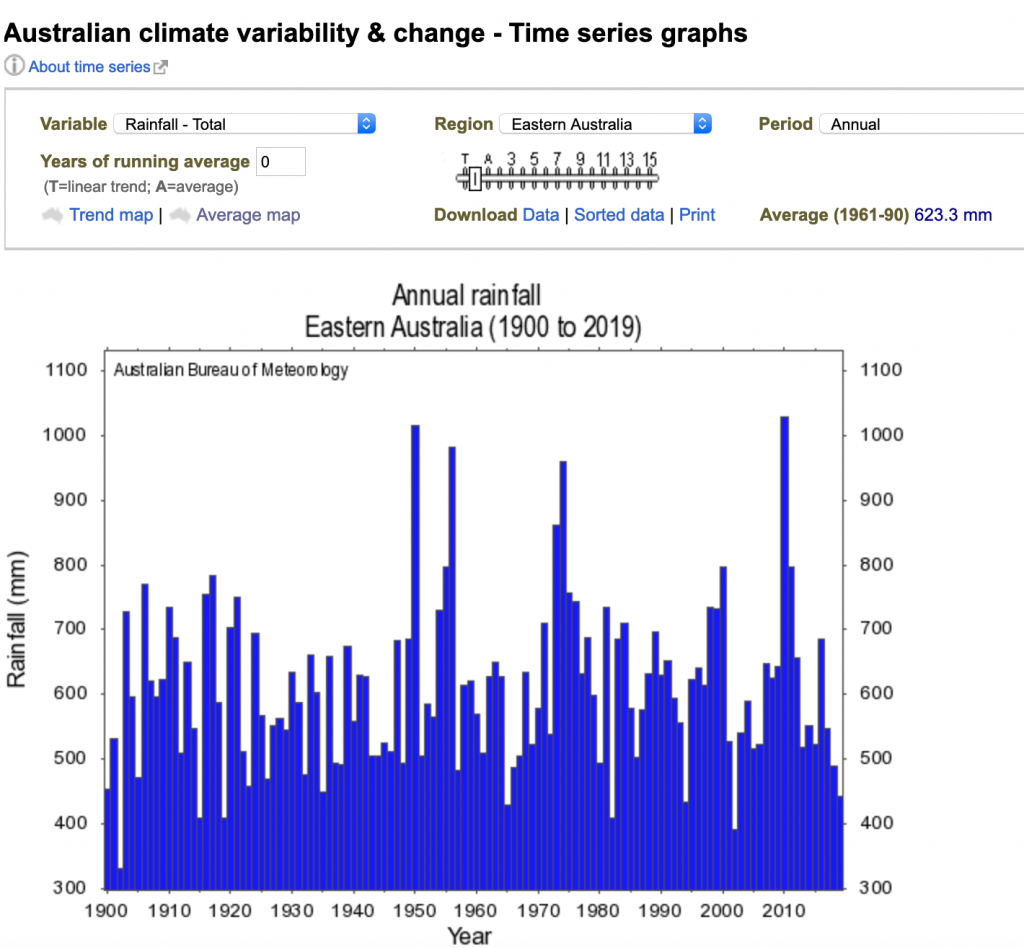





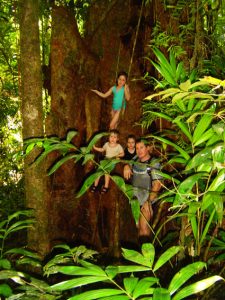
 Jennifer Marohasy BSc PhD has worked in industry and government. She is currently researching a novel technique for long-range weather forecasting funded by the B. Macfie Family Foundation.
Jennifer Marohasy BSc PhD has worked in industry and government. She is currently researching a novel technique for long-range weather forecasting funded by the B. Macfie Family Foundation.